Student funding in further education
Research into the financial behaviour of further education students in Scotland, exploring demand for and potential impact of student loans amongst this group.
4. Key findings: Feedback on student loans
Chapter Summary
- The research found a high level of general awareness of student loans amongst the FE student population, but a lot of uncertainty around the details of these.
- Two thirds of survey respondents said that they would be likely or very likely to apply for a student loan if was available to them. One quarter were not sure and the remaining 17% said they would be unlikely or very unlikely to take out a loan.
- Parents and carers responding in the survey were found to be the most likely to apply for a student loan, whilst those groups were also more likely to be in debt and most likely to be very worried about their financial situation.
- Student groups who were care-experienced, male or living in affluent areas were the least likely to apply for a student loan according to the survey. However, there is not a large difference in levels of demand between the cohorts, suggesting there is evidence of demand from all student groups.
- Student loans would mainly be used to cover basic living costs, course materials and unplanned expenses which reflects the current uses of debt by most students to cover essential living costs.
Introduction
4.1 This chapter reports the feedback from research participants on student loans. It begins with an overview of general levels of awareness and attitudes towards student loans, followed by a review of the evidence of demand and potential impact of these.
Overview
There were high levels of general awareness of student loans amongst the FE student population, but a lot of uncertainty and misinformation around the details of these.
4.2 Almost all focus group participants had heard of student loans and had some idea about them but lacked detail of the specific terms and conditions associated with them. In general perceptions were reasonably positive – loans were typically viewed as an essential source of financial support to enable students to complete their studies.
4.3 However, there were some negative perceptions of student loans. These often stemmed from anecdotal experiences from friends and family and mainly related to concerns about interest rates. For example, one student said that she had a friend who had a student loan and that the value of this had tripled over ten years due to high levels of interest. Another said that her sister was paying hers off, but that the monthly payments were not covering the interest and so the overall value was increasing.
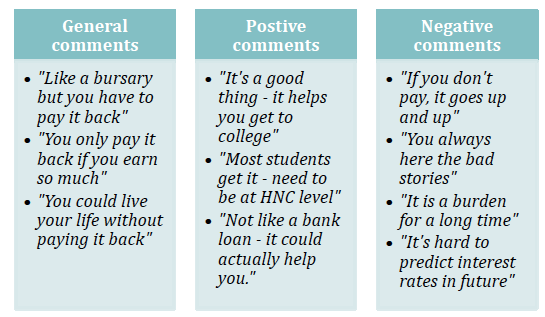
Figure 4‑1: Perceptions of student loans
Source: focus group participants
4.4 Figure 4‑1 shows comments made by focus group participants when asked by the facilitators what they already knew about student loans at the start of third task. Following this, the focus group facilitators explained the key principles of student loans to focus group participants before facilitating a detailed discussion on these. Participants were given a written copy of the key principles for reference (see Annex H). At the end of the discussion, students were asked to vote on how likely they would be to apply for the student loan if it was available to them.
Demand for student loans
Two thirds of survey respondents said that they would be likely or very likely to take out a student loan if they were eligible for one.
4.5 A short paragraph was included in the online survey explaining the key principles of student loans. Respondents were then asked how likely they would be to apply for this if it was made available to them. Figure 4‑2 shows that:
- Almost half (45%) said they would be very likely to apply for a student loan if it was available to them
- A further 17% said that they would be likely to apply for this
- Relatively few (12%) said that they would be unlikely or very unlikely to apply for a student loan
- A quarter (26%) said they didn't know or were not sure if they would apply, suggesting that they would need further information to decide.
4.6 The feedback on this question from focus group participants was much more polarised, withroughly equal proportions of participants saying that they would be very likely or very unlikely to apply for a student loan if it was available to them. This may reflect that the people who made the effort to attend the focus groups felt more strongly about the issue or that by attending and gaining greater information students felt more able to express a stronger opinion.
Figure 4‑2: If you were eligible for a student loan, how likely do you think you would be to apply for this?
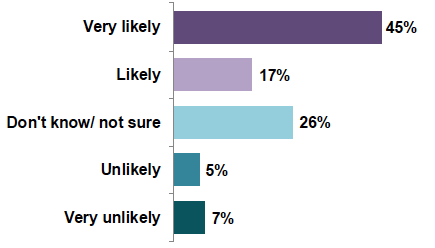
Source: SQW Survey of FE Students
Base: all respondents (2,060)
4.7 Figure 4‑3 shows that less than a third (29%) of students who were under the age of 18 said they would be very likely to apply for a student loan if it were available to them. Younger students aged 16-17 were less worried about their financial situation. This was confirmed through the focus group discussions, during which most of the younger participants said that they did not have major money worries. They typically had minimal outgoings (most were still living at home and being supported by their parents) and had not been used to having a lot of money having come straight to college from school. They may therefore feel that they would not need a student loan.
4.8 This could also be related to the lower levels of financial literacy amongst this cohort. The younger students that participated in the focus groups were in general, unfamiliar with common financial terms, such as interest rates. Some also lacked a basic understanding of mainstream financial products, such as credit cards, overdrafts or ISAs. There were several examples of where this lack of financial literacy had led them to take out unsecured debt at a young age, which they subsequently regretted.
Figure 4‑3: Percent of survey respondents by age category who said they would be 'very likely' to apply for a student loan if they were eligible for one
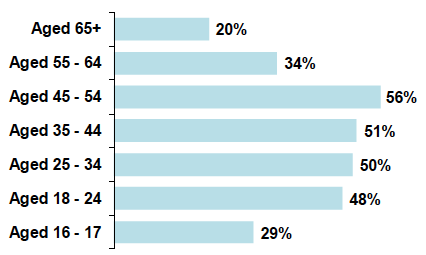
Source: SQW Survey of FE Students
Bases: total respondents in each age group
(aged 65+ n = 1; 55–64, 10; 45–54, 40; 35–44, 98; 25-34, 182; 18-24, 474; 16-17, 120)
4.9 Around half of all those aged 18-54 said that they would be very likely to apply for a student loan, with those aged 45-54 being the most likely. Students in their 30s and 40s were more likely to be parents, have financial commitments and be used to a higher level of income. In the focus groups, parents were more vocal about facing financial difficulties and this may influence their attitude towards student loans. Relatively few of those over the age of 55 said that they would be very likely to apply for one.
Parents and carers would be most likely to apply for a student loan, whilst those who are care-experienced, male or living in affluent areas would be the least likely. However, there is not a large difference in levels of demand between the cohorts, suggesting there is evidence of demand from all student groups.
4.10 Looking in more detail at the profile of the 45% of survey respondents who said that they would be 'very likely' to apply for a student loan, Figure 4‑4 shows that:
- Lone parents and parents would be most likely to apply – this also came out of the focus group discussions with parents being most positive about student loans, mainly due to their financial circumstances
- Those who were care-experienced, male or living in SIMD90 were found to be least likely to apply – although two fifths of those in each of those cohorts still said they would be 'very likely' demonstrating some evidence of demand.
Figure 4‑4: Percent of survey respondents by demographic characteristic who said they would be 'very likely' to apply for a student loan if they were eligible for one
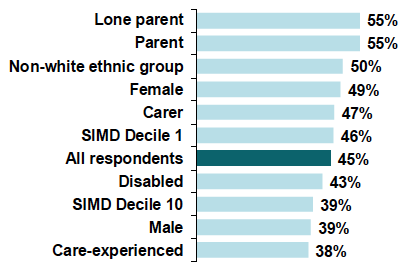
Source: SQW Survey of FE Students
Bases: total respondents (n=933) in each age group
(lone parent n=129; parent, 269; non-white ethnic group, 54; female, 606; carer, 198; SIMD decile 1,175; disabled, 104; SIMD Decile 10, 30; male, 299; care-experienced, 54)
4.11 Figure 4‑5Error! Reference source not found. shows that almost three quarters (74%) of all lone parents completing the survey were in debt. This was more than double the equivalent figure of 34% for all respondents. This may account for a more positive attitude towards student loans.
4.12 Male students and those living in SIMD90 areas were least likely to be in debt and two of the groups least likely to be worried about their financial situation. These experiences and attitudes may be reflected in their lower likelihood to take up a student loan.
Figure 4‑5: Percent of survey respondents who were in debt
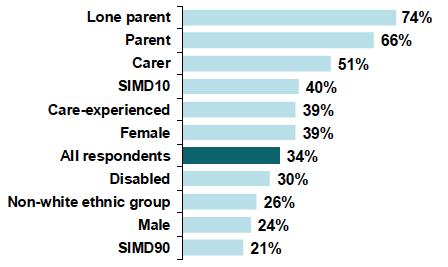
Source: SQW Survey of FE Students
Bases: all respondents (n=692) in each cohort (lone parent n=173; parent, 323; carer, 218; SIMD10, 16; care-experienced, 56; female, 486; disabled, 74; non-white, 28; male, 182; SIMD90, 152)
SIMD10 = most deprived 10% of data zones in Scotland
SIMD90 = least deprived 10% of data zones in Scotland
Student loans would mainly be used to cover basic living costs, course materials and unplanned expenses.
4.13 Figure 4‑6 shows how those who said they would be likely / very likely to apply for a loan would use this. The most frequent response was to cover basic living costs, cited by 39% of the total. This was followed by course materials, unexpected costs and cars. For some students living in rural areas, cars were viewed as an essential item (rather than a luxury) to enable them to attend college. Relatively few (5%) said they would use a loan to pay for additional luxuries.
Figure 4‑6: If you accessed a student loan, what would you use it for? Please select all that apply.
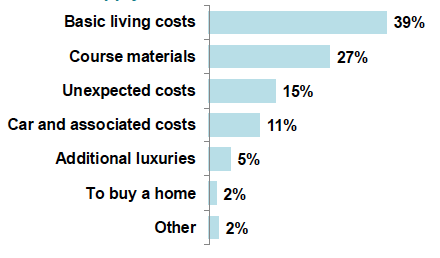
Source: SQW Survey of FE Students
Base: those who said they would be likely / highly likely to apply for a student loan (1,283)
4.14 Some of those who selected 'other' said they would use the loan to pay off other (more expensive) debt. This was also a key finding from the focus groups discussions.
Most students who were in debt had used this to cover essential living costs and relatively few had used it to pay for luxuries.
4.15 Figure 4‑7 shows that the purposes of existing student debt reflect similar reasons to their purposes intended for the student loan by those likely to apply for one. This includes:
- The most commonly cited reason for getting into debt was to pay for basic living costs, such as rent, food and bills – 43% had used it for this purpose
- Nearly a quarter (23%) cited unexpected costs as the purpose of their debt – from the focus group discussions, this could include things like family illness or bereavement or household maintenance / repairs
- Around one in every ten (9%) had taken out debt to cover the cost of course materials – some courses were reported to have a lot of requirements for resources and equipment
- Relatively few went into debt to pay for luxuries (5%) or buy a property (1%).
Figure 4‑7: What was the purpose of the debt? Please select all that apply
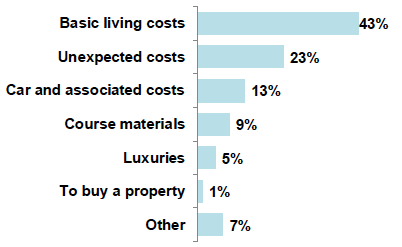
Source: SQW Survey of FE Students
Base: those who said they were in debt (686)
Students unlikely to apply for a student loan tended to have negative attitudes towards debt.
4.16 Survey respondents who said they would be unlikely to apply for a student loan were asked why. Their responses were wide ranging. The most frequently cited reasons related to: negative attitudes towards debt; not needing one; worry about repayments; and not wanting to get into more debt (Figure 4‑8).
Figure 4‑8: Why would you be unlikely to apply for a student loan?
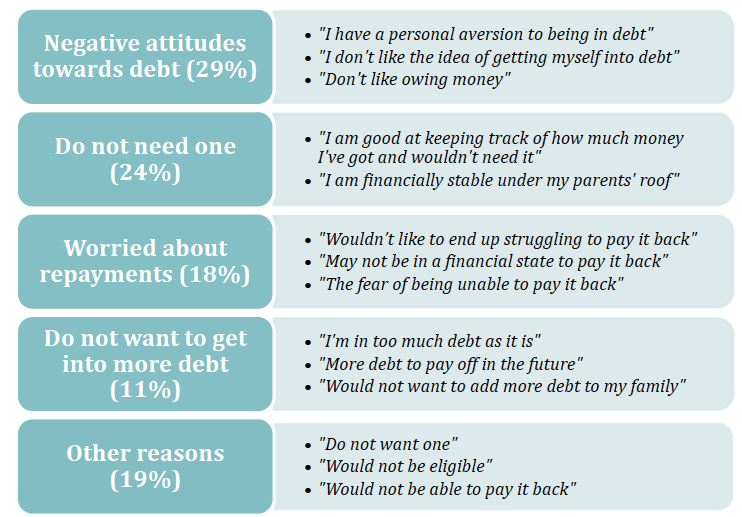
Source: SQW Survey of FE Students
Base: those who said they would be unlikely / very unlikely to apply for a student loan and gave a reason for this (199)
Free text responses
Most research participants were averse to the idea of taking on debt unless they absolutely had to.
4.17 Most of the students who participated in the research through the focus groups and the survey were in difficult financial circumstances. However, most of them did not see debt as a route to addressing these issues. The consensus was that whilst debt may help ease the pressure in the short term, it would ultimately make things more difficult for them. In the focus groups, these attitudes were found to have stemmed from:
- Parental influence – particularly amongst the younger students, many of whom said that their parents had encouraged them not to get into debt
- Lack of financial literacy – as referenced in the previous section, many of the younger students were not familiar with common financial terms / products
- Negative experiences – a lot of the older students were averse to debt due to negative previous experiences, whilst many others had witnessed friends / family members getting into financial difficulties because of debt
- Fear of not being able to pay it back – this was a recurring theme in the focus group discussions and the survey open responses. Around half of the students were not confident in their future earning potential and were reluctant to get themselves into a situation that they might struggle to get out of
- Religious reasons – several students, particularly those who were Muslim, considered debt to be against their religious beliefs
- Potential impact on mental health – focus group participants often referenced the stress associated with being in debt. One commented that it "makes it difficult to feel good about yourself."
Potential impact of student loans
For some students, access to a student loan would be a "lifeline" enabling them to stay in college and support their families.
4.18 The research only engaged current college students, but at least one student per focus group said they had seriously considered dropping out due to financial worries. In most of these examples, they had been convinced to stay by family members or partners who had offered to support them to enable them to stay. Others referenced high drop-out rates on their courses for this reason. For these students, access to a student loan could be a "lifeline" enabling them to stay in college.
It would help reduce the pressure on wider friends and family.
4.19 Most focus group students who participated in the research were highly dependent on financial support from friends and family to enable them to attend college. Around a quarter of students surveyed were dependent on friends and family and this was the most common source of lending for students. This was reported to be putting additional pressure on wider family members, particularly those who were living in deprived areas or who were parents. Access to a student loan could potentially help reduce this.
"My son is paying £97 rent per week and the council tax. We rely on him to cover these costs – me and his brothers and sisters. It's not right. He's in a minimum wage job. He shouldn't have to do that just because I'm going to college."
Focus Group Participant
It could encourage more people to consider going back to college to retrain and upskill.
4.20 A key point of discussion during the focus groups was how challenging it was for older returners to take the decision to go back to college and retrain. They typically must adapt to living with a much-reduced income. It was thought that this was a barrier for many to taking this potentially positive life decision. Access to a student loan could help encourage more to do this.
Other key issues for consideration
Student loans in further education need to be flexible enough to suit different types of learner journeys.
4.21 In the focus groups students talked about their learner journeys. Many of them had changed courses since they first entered further education and did not yet have a clear career path in mind. Most students also thought that it was unfair to penalise people who want to change career or better themselves by charging fees for returning to education after a long period. Carers and lone parents were especially considered to be at a greater disadvantage due to this. Given these experiences, students questioned how a loan may affect future funding options if they decided to change their course, take a break from education or progress into higher education.
"There is no point in taking out a loan for a course at a low level when these are the courses that people change their mind about all the time. Most people in college change their mind."
Focus Group Participant
4.22 Previous research into student learner journeys[32] shows young people at risk of disengagement from education are often encouraged to complete college applications, despite having no intention of taking a place if successful. Related to this issue, in a focus group one student who attended in their capacity as a representative from the Students' Association reported that it was common for some students to attend the first few weeks of college to receive their bursary payment and then leave. There is a risk that similar issues could arise with loans. One way to mitigate this situation would be to schedule student loan payments over the whole calendar year.
Support for students completing the required student loan paperwork is important.
4.23 Almost all students in the focus groups reported difficulties with their bursary applications. This included understanding the administration process, completing the paperwork and providing the evidence requirements associated with these. Students talked about being unable to find biological parent birth certificates, uncertainty about where to get documents from and not having enough time to find paperwork.
4.24 There are similar processes involved in student loan applications, including submitting deferment paperwork on an annual basis. Student experiences of the bursary process suggest they may find the student loans process difficult to navigate without additional support. The need for evidence requirements also represents a risk for students reliant on other external agencies for paperwork, such as Job Centres or aftercare services.
Information about the impact of student loans on welfare benefits, particularly Universal Credit, needs to be clear and consistent.
4.25 Students in the focus groups showed a general lack of understanding of how bursary payments interacted with other forms of income, particularly welfare benefits. The types of benefit applicable alongside bursaries varies by individual circumstance and students found it difficult to access consistent information based on their specific needs.
4.26 These concerns were echoed in conversations about the impact of student loans in FE. In particular, students who had recently been migrated onto universal credit and had negative experiences of this were concerned they would face the same problems.
Contact
Email: fraser.syme@gov.scot
There is a problem
Thanks for your feedback